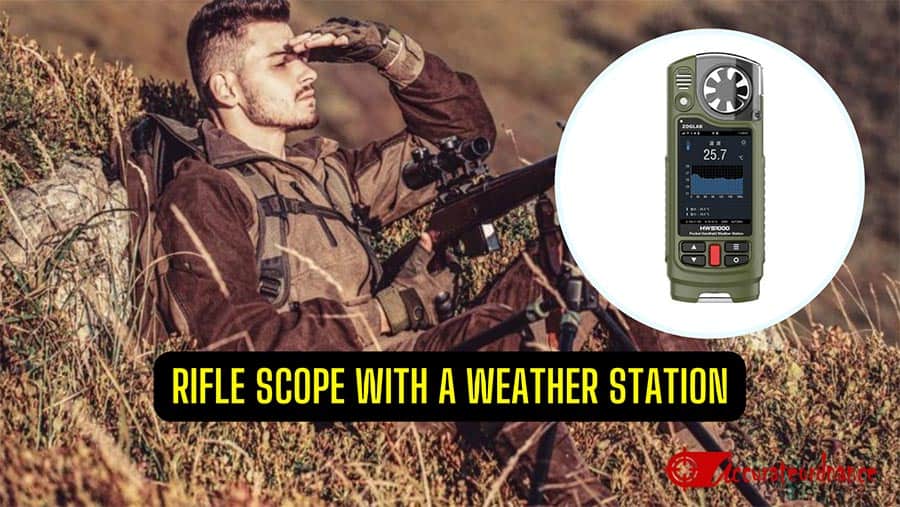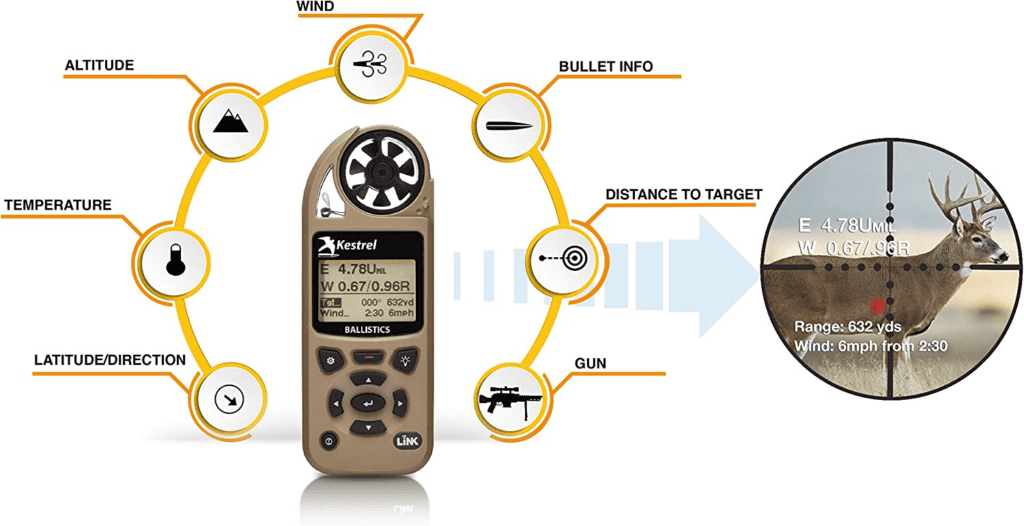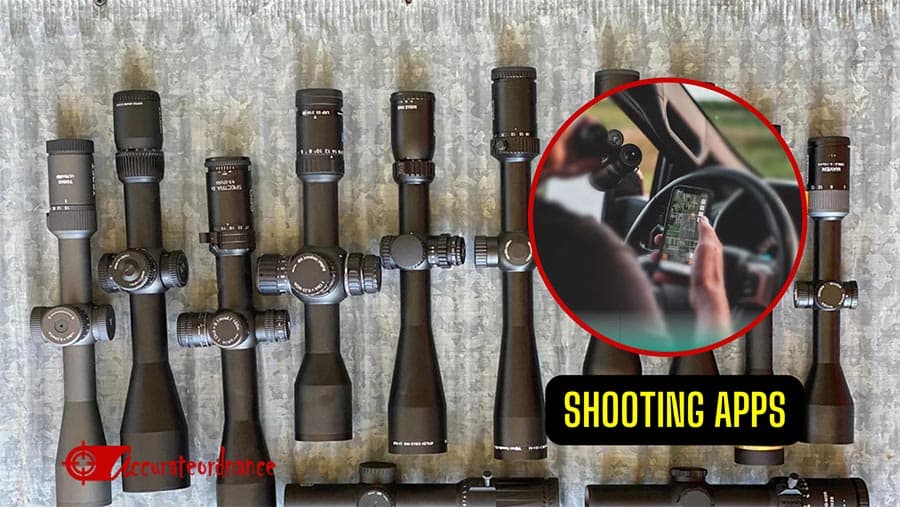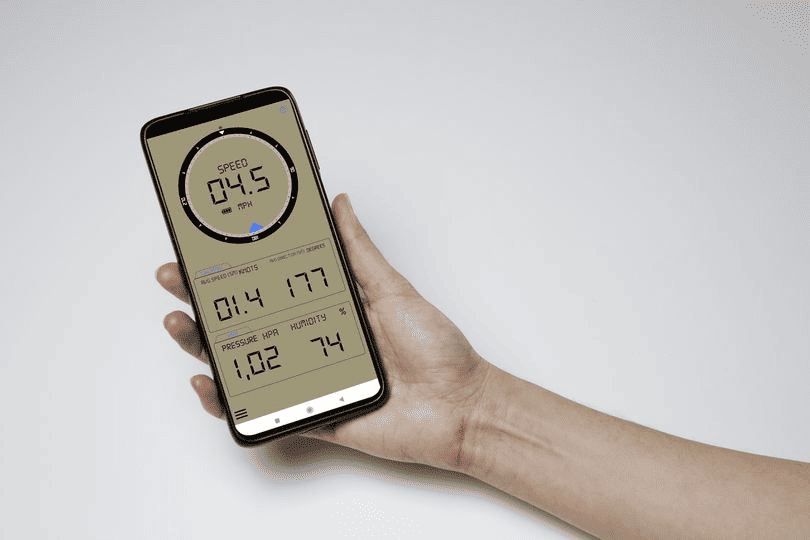As a sharpshooter extraordinaire, I’m well aware that Mother Nature can get in the way, messing with your shots in the blink of an eye. So, to keep my aim on point, I always pack a trusty weather station when I’m roaming in the wild. By combining the power of a high-quality rifle scope with the real-time data a weather station provides, you can make more accurate and informed shooting decisions.

Whether you’re a competitive shooter looking to gain an edge over your opponents, or a hunting enthusiast hoping to bag your next big game, the benefits of using a rifle scope with a weather station are undeniable. In this article, we’ll explore the many advantages of having a weather station alongside your scope. We’ll also look at the different types of weather stations available, as well as the various features and capabilities of this tool.
Types of Weather Stations for shooting
Several types of weather stations can be used for shooting. The type of weather station that is best for you will depend on your specific preferences. Here are some common types of weather stations for shooting:
Handheld Weather Stations
You know that every second counts when you’re out on a hunting trip or shooting expedition. The weather can change in an instant, and if you’re not prepared, it can throw off your aim and ruin your shot. That’s where handheld weather stations come in. These small, portable devices can be a lifesaver when you’re on the move and need real-time weather data at your fingertips.
I’ve used handheld weather stations on many of my shooting expeditions, and I can’t imagine going without one. They’re so easy to carry around and don’t take up much space in your gear bag. But the real value of a handheld weather station is in the data it provides. Every little bit of information can make a big difference when you’re out in the field. By having access to real-time weather data, including temperature, barometric pressure, and wind speed, you can adjust your aim and trajectory on the fly to make the perfect shot.
Of course, not all handheld weather stations are created equal. Some models can be finicky or require complicated calibration, which can be frustrating when you’re out in the field. That’s why it’s important to choose a handheld weather station that is accurate, reliable, and easy to use. Look for models from reputable manufacturers and good reviews from other shooters. You should also consider the device’s features, such as the size and weight, battery life, and the quality of the sensors.

In my experience, handheld weather stations are particularly useful for hunting trips or shooting expeditions where you must quickly move from location to location. They’re also great for shooters who prefer to travel light and don’t want to lug around heavy equipment. Whether you’re a seasoned professional or a beginner, a handheld weather station can be a valuable tool in your shooting arsenal.
Features of a Handheld Weather Station
Compact size
Handheld weather stations are designed to be portable and easy to carry around. They can fit in a shooter’s pocket or attach to a backpack or belt, making them convenient for use in the field.
Accurate readings
Handheld stations are equipped with sensors that can measure temperature, wind speed and direction, barometric pressure, and humidity. These sensors provide accurate readings that shooters can use to adjust their shooting strategy.
Digital display
Most of them come with a digital display that shows the current weather conditions. This display is easy to read and provides shooters with authentic weather data.
Alarms
Some handheld stations have alarms that can alert you to changes in weather conditions. For example, an alarm can be set to go off when wind speeds reach a certain threshold.
Data logging
Some of these handheld tools can also store data on weather conditions over a period of time. Shooters can use this data to track changes in weather patterns and adjust their shooting accordingly.
Connectivity
Some handheld weather stations can be connected to a smartphone or tablet via Bluetooth. This allows shooters to view weather data on their mobile devices and share data with other shooters or coaches.
Smartphone Apps
Mobile phones are like oxygen to many people in this age, and in recent years, there has been an explosion of smartphone apps that can be used as weather stations for shooting. These shooting apps are a convenient and cost-effective option for shooters who already carry a smartphone with them.

With the right app, you can get real-time weather data, including temperature, pressure, and wind speed, all at the touch of a button. The best part is, many of these apps are free or available at a low cost, making them accessible to shooters of all skill levels and budgets.
In my experience, smartphone apps can be particularly useful for shooters who are shooting at a fixed location, such as a range or shooting competition, and don’t need to constantly move around. They can also be great for shooters who prefer to travel light and don’t want to carry extra equipment. Plus, with the ability to set location-specific weather alerts, you can stay on top of any changes in the weather and adjust your aim and trajectory accordingly.
However, choosing a reliable and accurate app is important, as some apps can be prone to errors or provide inaccurate data. Look for apps that have good reviews from other shooters and are regularly updated to ensure they provide the most up-to-date information. It’s also important to keep in mind that smartphone apps are not as precise as other weather stations, so you may want to double-check the data they provide with other sources if you’re looking for the utmost accuracy.
Features of Smartphone Apps
Ballistic Calculators

Many smartphone apps provide ballistic calculators that can help shooters calculate the bullet trajectory, windage and elevation, and range. These calculators use data such as bullet weight, velocity, and other environmental factors to make calculations, providing shooters with more accurate information to adjust their aim.
Weather Monitoring
Some apps provide weather data like temperature, humidity, and pressure. This information can help shooters make informed decisions about when and where to shoot and how to adjust to environmental conditions.

Gun Database
Some apps have a database of different firearms, including their specs and ballistics data, that can be used to calculate the bullet trajectory for specific guns.
Shooting Logs
Many apps allow users to log their shooting sessions, recording details such as the gun used, the ammunition, the range, the target distance, and any notes on wind and weather conditions. This feature can help shooters track their progress and identify areas where they need improvement.
GPS Capabilities
Some apps have GPS capabilities that allow shooters to record their shooting location and track their movements.
Training and Education
Finally, smartphone apps have training and education resources, including instructional videos, articles, and tips from professional shooters. These resources can help shooters improve their skills and learn new techniques.
Stationary Weather Station
Stationary weather tools are great for shooters who need to collect long-term data on weather. These weather tools are typically set up in a fixed location, such as a shooting range or training facility, and can provide accurate weather data over an extended period.
Whether you’re training for competitions or just want to collect data on your shooting performance over time, stationary weather stations can be incredibly valuable. With the ability to collect data over days, weeks, or even months, you can get a clear picture of how weather conditions affect your shooting accuracy and adjust your techniques accordingly.
Features of Stationary Weather Station
Stationary weather stations are designed to provide detailed and accurate weather data for a specific location. They are often used by shooters, hunters, and other outdoor enthusiasts to plan activities and make decisions based on the current and forecasted weather conditions. Some of the features include:
Multiple Sensors
Stationary weather tools usually have multiple sensors to measure various weather parameters. These sensors work together to provide a complete picture of the weather conditions at a specific location.
Data Logging
Many stations are equipped with data logging capabilities, allowing them to record and store weather data over time. This feature is useful for shooters who want to track weather trends and patterns at a particular location.
Power Options
Stationary weather stations can be powered by various sources, including solar panels, batteries, and AC power. The type of power source used will depend on the location of the weather station and the needs of the user.
Benefits Of Using A Weather Station
Real-time Data
One of the primary benefits of using a weather station with your rifle scope is the ability to access real-time data about weather conditions. This information can be critical for making informed decisions about your shooting and adjusting your aim and ammunition. Having this data readily available lets you make quick adjustments to your shooting.
Improved Accuracy
With a weather station, you can get real-time data on wind speed and direction, temperature, and other factors that can affect the path of your bullet. This data can help you make more precise adjustments to your aim, improving accuracy and increasing your chances of hitting your target.
Long range Shooting
If you enjoy long range shooting, a weather station is an indispensable tool. By providing information on environmental factors that can affect the bullet’s path, a weather station can help you adjust your riflescope so that you can hit targets at longer distances. This is especially important when shooting in unpredictable weather conditions or when there are strong winds, as even the slightest adjustments can make a significant difference when shooting longer ranges.
Competitive Advantage
In competitive shooting, every advantage counts, and a weather station can give you an edge over your opponents. Whether you’re shooting in a local competition or at a national level, a weather station can help you gain a competitive advantage.
Reduced Guesswork
The way that a ballistic reticle takes the guesswork from your holdover aiming is the same way the weather devices do. A weather station can help reduce guesswork by providing accurate and real-time results on the weather situation.
Improved Planning
Planning your shooting activities can be easier with a weather device, thanks to access to its historical weather data. You can plan your shooting around optimal weather conditions and avoid unfavorable weather that may negatively affect your shooting performance. This approach can help you stay ahead of the weather and ensure you’re prepared for any conditions.
Increased Confidence
Shooting in changing weather conditions can be challenging and even intimidating. However, with the precise data provided by weather stations, you can feel more confident in your shooting decisions. This increased confidence can help you approach each shot with greater focus and intensity, leading to better results and improved shooting success.
Time-Saving
Using a weather tool can also save you time by providing you with quick data on weather conditions. Rather than having to spend time manually measuring weather conditions, you can simply check your weather station and get accurate data in seconds.
Applications of Rifle Scope with Weather Station
Hunting and Wildlife Observation
One of the ways you can use your riflescope with a weather station is during hunting and wildlife observation. Picture yourself as an enthusiastic hunter embarking on an early morning hunting trip. As you prepare, you attach a riflescope to your rifle and head for the woods. During your hunt, you spot a magnificent buck standing at a distance. You observe that the wind is blowing at a relatively high speed, requiring you to adjust your aim to compensate for its impact on the bullet’s path. But how would you go about this? This is where a weather station comes in handy. The weather station can reveal a drop or increase in wind speed and temperature, signaling potential changes in air density that can affect the bullet’s flight.
To get an accurate shot, you need to glance at the weather station before pulling the trigger. It displays essential information like wind speed, temperature, humidity, and atmospheric pressure. With the data provided by the weather station, you can make the necessary adjustments to your aim and take the shot. This is why the combination of a rifle scope with a weather station proves invaluable for hunting. By having access to real-time environmental data, you can make informed decisions and adapt your shooting technique accordingly. This increases your chances of hitting the target with precision, even in challenging conditions.
Moreover, the riflescope with a weather station enhances wildlife observation as well. By knowing the wind speed, for instance, you can position yourself downwind of the animals you are observing, avoiding alerting them to your presence. The weather data enables you to understand the environment better and make informed decisions, maximizing your wildlife observation experience.
Long-Range Shooting Competitions
The combination of a rifle scope and a weather station is highly beneficial for long-range shooting competitions. These competitions involve precision shooting at distant targets and often take place in challenging outdoor environments. The use of a weather station together with a rifle scope offers significant advantages in such events.
Shooters participating in long-range shooting competitions need to consider external factors that can impact bullet trajectory. Variables like wind speed, wind direction, temperature, humidity, and atmospheric pressure greatly affect shot accuracy. By using a weather station, shooters can gain access to real-time data that enables them to make precise adjustments and improve their performance. By making precise adjustments based on the weather station’s information, you increase your chances of hitting the target accurately, even at extreme distances.
Tactical and Military Operations
The combination of a rifle scope with a weather station is highly valuable in tactical and military operations. In scenarios such as reconnaissance missions, sniper operations, and tactical engagements, the ability to gather real-time environmental data and make accurate adjustments is essential.
When military personnel uses a rifle scope for long-range targets, they need an additional tool to gain access to more insights about the weather conditions. Let’s take the example of a sniper team deployed on a covert mission with the objective of eliminating a high-value target in a remote area. To succeed, the sniper must consider variables like wind speed and direction, temperature, humidity, and atmospheric pressure.
By utilizing a rifle scope with a weather station, the sniper can gather critical environmental data and calculate the necessary adjustments to compensate for these variables. For example, if the sniper observes that the wind is blowing from the southeast at a moderate speed, the weather station can provide precise wind speed information. This allows the sniper to estimate the wind drift and adjust the aim accordingly. The sniper also takes note of temperature and atmospheric pressure data from the weather station. With this information, the sniper can calculate the adjustments needed to account for changes in the air, which directly affect the bullet’s flight path.
FAQS
What kind of shooting is a riflescope and weather station best suited for?
A riflescope and weather station combination is beneficial for long-range shooting, where even small environmental factors can have a major impact on accuracy. It is also useful for hunting, where a shooter may need to adjust for changing weather in the field.
How does the magnification level of an optic affect its performance with respect to weather?
The magnification level of an optic is important for long-range shooting, as it allows for more precise aiming and targeting. With respect to weather, you might need a little more magnification.
How does a ballistic solver work with a weather station?
A ballistic solver is a tool that helps shooters calculate bullet trajectories based on environmental factors. Some weather stations may not be able to make ballistic calculations, so after measuring the environmental factors, you can use the ballistic solver to get your final result.
Can a weather station be used in low-light or nighttime conditions?
Yes, digital weather stations can be used at night. They function just like riflescopes that are equipped with night vision or thermal imaging capabilities, allowing shooters to use them in low-light conditions.

Mike Hardesty is a published freelance gun writer. He also possesses specialized expertise in rifle scopes With dozens of articles and reviews published in Pew Pew Tactical, Snipercountry.com, and TTAG (The Truth About Guns), Mike is considered a firearms expert. His special area of expertise is handguns.
Mike is a long-time shooter. He has been punching paper targets, taking deer and other game and shooting at competitions since about 1975. Other related pursuits include reloading and bullet casting. He currently reloads for over 10 calibers, both handgun and rifle. His reloads, particularly for 9mm, were in great demand during the height of the ammo shortage among family and friends. He donated hundreds of rounds to informal shooting sessions. He was quoted as saying “I do not sell my reloads but I sure will help my guys shoot ’em for free!”. He has a few cherished firearms that he has inherited or otherwise procured — those are his favorites.
He earned B.S. and M.S. degrees from Indiana State University in 1974-1975.
He’s a firearm experts and is the founder of mhardesty.com.
